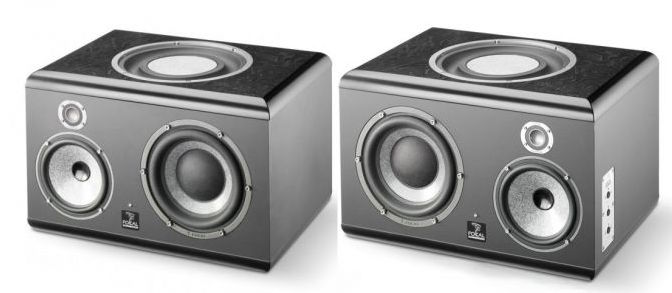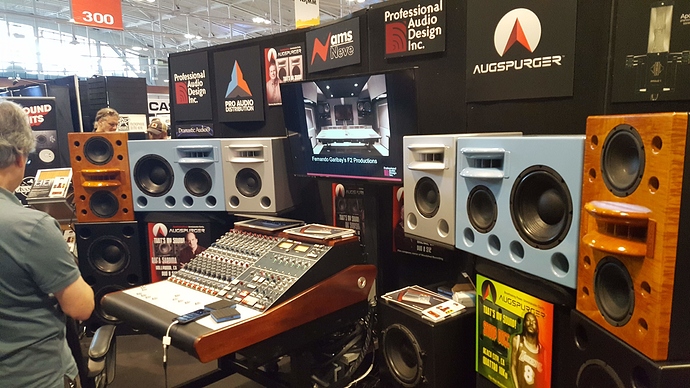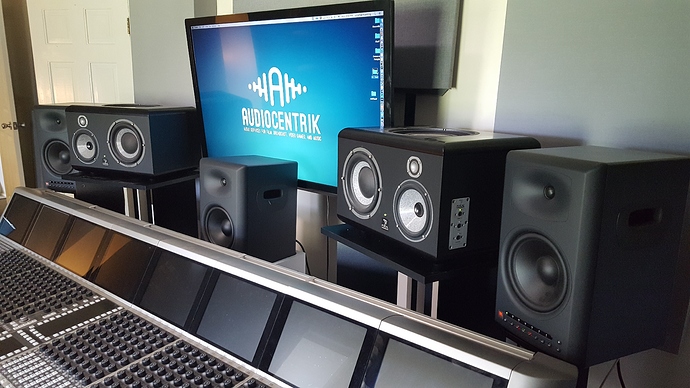Hey Paul, I like the way your brain works, I get the picture immediately! Now I’ll never be able to think of a subwoofer as anything other than a big old dog in a sub:joy:


I don’t knock home systems at all. I have an old JBL home system hooked up in my control room. It has more accurate low end than any studio monitor I’ve ever heard.
Bob, does the definition of a sub hinge on weather it’s a separate unit, or weather its kicks out low end frequencies? I guess I’ve considered these as built in subs. I dunno. They go down to 20 hz, but not real well. However, I think they do good for their size. Some people think the passive radiator is gimmicky, I personally like the way the crossover is voiced. And I liked being able to trust it strait out of the box.

I heard these the other day… this was at NAMM. The sub built into the speaker didn’t seem to make a difference between the ones in the units and the separate sub on the floor… Dave said they’re the exact same box and as the blue ones in the middle, and they really sounded the same to me, granted those guys really know how to tune their subs lol.
Hey Jonathan,
I read your post about the high end monitors at NAMM before, but I was wondering if you can hear the subtle differences of really good monitors in a noisy environment like NAMM? I’ve never been mind you, so this is just out of interest!
By the way, thanks for your boost of confidence that my hearing is getting better  . I hope that comes out in my productions (check my recent submission Funky Fever for the 50’s mix completion).
. I hope that comes out in my productions (check my recent submission Funky Fever for the 50’s mix completion).
The Augspurger booth was in an entirely different section of the showroom where you could speak at a relatively low volume and still be able to hear. I could talk on my cellphone without raising my voice, and I could hear the dude standing behind me smacking on his chewing gum lol. If I listened, I could hear the conversations the other Augspurger guys were having with others standing around the booth.
I asked them how they were even able to tune their systems, and Dave said they set up at 4:00 a.m. in the morning so they could get their hardware wired up and and calibrate the RMC mics without any interference from other vendors. Also, since the guitars amps and drums were in an entirely different part of the building, they were the decibel police weren’t strict with this booth. There were a couple of demos where they showed me what the system was capable of and as long as I wasn’t ridiculous about it, no one minded when I cranked these suckers as loud as a Marshall stack.
Here’s my take on it…they’re not any clearer than Barefoots or Focals. What they do is get louder and are quite revealing at high volumes. So I think they do give an overall better sense of cinematic style sound (which is what I tested on them). What I noticed is there’s a warm rich density in that troublesome 300-800 range when action sequences get intense and hundreds of sound effects are competing with music and explosions in the LFE channel (which wasn’t set up as an LFE channel because these were wired in stereo). But the richness in that range isn’t merely big, its deep, layered, and controlled. So I think these are incredibly clear, but in a different way than the Barefoots which probably have the most pristine HF drivers I’ve ever heard and the Focals that have an extraordinary amount of detail at 3-7k where the definition in vocals is often fine tuned. They would probably take some time to learn to adapt to…more than it would take me to get used to hearing a pair of Yamaha HS7’s or Genelecs. I think I expected the Augspurgers to really shimmer on the top end (because of how they’re known for their horns), and I was a bit surprised when they didn’t, but they are a mid-range and not a near field speaker at heart.
The big reason for subs in home systems is that in 5.1 or 7.1 systems, (Or Atmos, or pretty much any multichannel format ) is that the.1 in the format is a separate bass channel being sent at line level and generally high passed at 80 hz or so. Of course, you could use a passive sub with a power amp dedicated to it. The bottom couple of octaves in a home system generally suck up about 80% of the power a 7 channel receiver has to offer if you try to go full range with your front speakers, and home receivers aren’t using great amplifiers in them, at least when you consider what a good studio would be using.
There is absolutely nothing wrong with a passive radiator, all it is really is a non powered driver that pushes the backwave of the woofer out of the cabinet and makes use of it to extend the frequency response of the drivers in that particular cabinet. In a sealed cabinet, that backwave (the air that moves in the opposite direction when the woofer comes back from its excursion) needs to be absorbed, usually with an absorbent material installed in the cabinet. As usual, it all boils down to the accuracy of the motion of the radiator, and whether it stays in relative phase of the active driver without flopping all over the place.
In any event, it can be extremely difficult to get good accurate bass response out of small monitors without adding a sub, but just adding a sub and not dialing everything in can be worse than not having one. What’s really cool today is all the room correction software you can use to correct for a lot of the issues they can cause, and I was kind of surprised that Paul wasn’t using one, although I’m sure his studio is very accurate, and quite a bit above the level of bedroom geezers like myself.
I guess I just get a little skeptical with all of the “monitors” out there. If a speaker is accurate and gives you a wide enough range to make correct decisions in your process, it can be used as a monitor. I think manufacturers are a bit liberal in their use of the term, and charge extra for some of the stuff they put out. On the small stuff, you have to be really careful with the low end capability, especially if the “specs” list a low end without a db deviation. In other words if your 5" woofer claims to get to 40hz, it will need to have a gigantic excursion to get there, and it will be flopping around like a kite in a strong breeze. Subwoofers can solve a lot of that, and if they are properly set up so that they just extend your monitor’s ability without smearing everything they can be very effective.
So these are on your whish list- with your increasing success in the film industry - ?
I guess before you spend so much on speakers you’d be allowed test them in your studio?
Good questions
The purchase would be about $36,000 (5 tops and a sub and the amps) so I don’t think it would be a good idea at the moment. Install and construction would easily hit another $5k because they do need to get out here to tune them, and they’d probably be a little bit of a mis-match for this room. Its really more about the room, if you make $15-$20k pr movie, you could actually pay these off with three or four contracts. I don’t have film work on a consistent enough basis yet to pull the trigger on these yet.
I don’t think that’s the case with these…it’d be sort of like closing on a house and then asking to live in it for 2 months with the option to change your mind later. By the time you eat the $5000 to get the guys down here to set them up, you probably need to fly to other studios around the country which Augspurger has partnerships with them to hear them in context. Honestly though, as much as I’ve spent hours pouring over dialogue between designers and clients, Augspurger is one brand that seems to have very few clients experience buyer remorse for any other reason than they bit off a loan payment they couldn’t really swallow. Most people who have them have found they can really trust them if they’re properly installed.
To clarify, the Focal Twin 6’s and the Sm9’s both have built in subs, the Sm9’s have subs PLUS a radiator. That’s what Focal is calling them anyway lol.
I know. When I mix anything in 5.1 I only use the Focals to check for translation when I toggle between the summing matrix fold. (That means when I collapse the 5.1 to stereo and check that everything still translates). The center speaker (JBL LSR 4300 series) in the picture is sitting on top of an actual Sub. In a few weeks I’m gonna move that TV up a foot and a half and put a the Pro Tools monitor on a rolling car off to the side of the mixer. I have all the speakers on 2 different output paths in ProTools and two different output paths on the CraneSong.
There is no possible way to achieve independent LFE channel monitoing using the subs on the Focals. The SM9’s have a 2 vs 3 way toggle with that allows you to bypass both the sub (on the front) and the passive radiator (on the top). However, you can’t feed the sub a separate channel - they only have one input, thus no dedicated LFE possibility. There’s still a lot of confusion in the music world, because I think some people still don’t understand that LFE does not equal Sub, and a lot of music mix guys never need to mess with a 6 bus.

